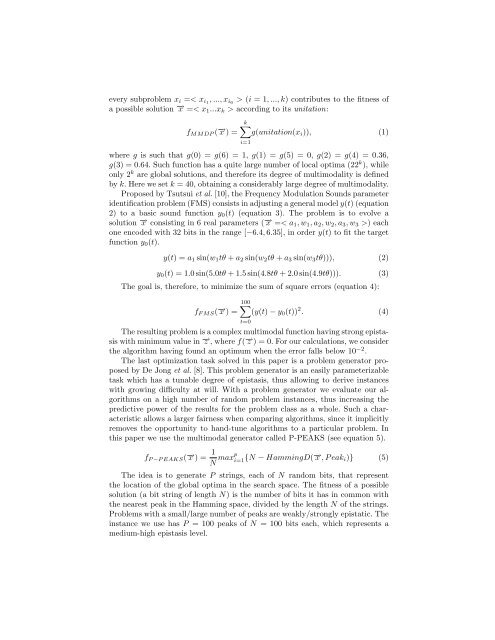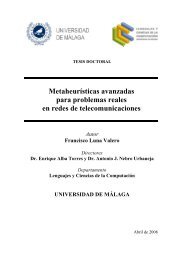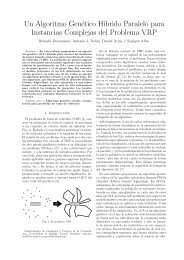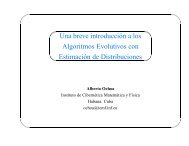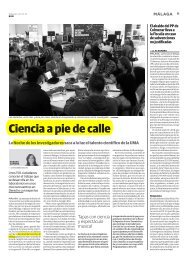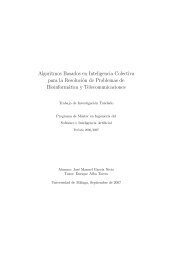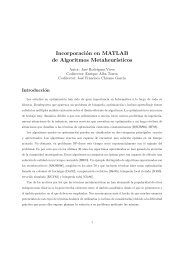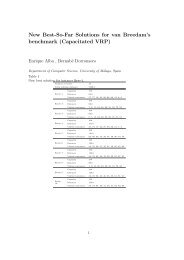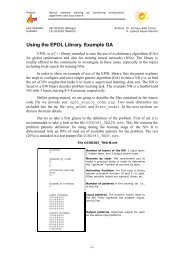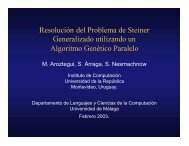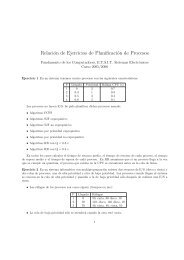Comparing Synchronous and Asynchronous Cellular Genetic ... - NEO
Comparing Synchronous and Asynchronous Cellular Genetic ... - NEO
Comparing Synchronous and Asynchronous Cellular Genetic ... - NEO
Create successful ePaper yourself
Turn your PDF publications into a flip-book with our unique Google optimized e-Paper software.
every subproblem xi =< xi1, ..., xi6 > (i = 1, ..., k) contributes to the fitness of<br />
a possible solution −→ x =< x1...xk > according to its unitation:<br />
fMMDP ( −→ x ) =<br />
k<br />
g(unitation(xi)), (1)<br />
i=1<br />
where g is such that g(0) = g(6) = 1, g(1) = g(5) = 0, g(2) = g(4) = 0.36,<br />
g(3) = 0.64. Such function has a quite large number of local optima (22 k ), while<br />
only 2 k are global solutions, <strong>and</strong> therefore its degree of multimodality is defined<br />
by k. Here we set k = 40, obtaining a considerably large degree of multimodality.<br />
Proposed by Tsutsui et al. [10], the Frequency Modulation Sounds parameter<br />
identification problem (FMS) consists in adjusting a general model y(t) (equation<br />
2) to a basic sound function y0(t) (equation 3). The problem is to evolve a<br />
solution −→ x consisting in 6 real parameters ( −→ x =< a1, w1, a2, w2, a3, w3 >) each<br />
one encoded with 32 bits in the range [−6.4, 6.35], in order y(t) to fit the target<br />
function y0(t).<br />
y(t) = a1 sin(w1tθ + a2 sin(w2tθ + a3 sin(w3tθ))), (2)<br />
y0(t) = 1.0 sin(5.0tθ + 1.5 sin(4.8tθ + 2.0 sin(4.9tθ))). (3)<br />
The goal is, therefore, to minimize the sum of square errors (equation 4):<br />
fF MS( −→ 100<br />
x ) = (y(t) − y0(t)) 2 . (4)<br />
t=0<br />
The resulting problem is a complex multimodal function having strong epistasis<br />
with minimum value in −→ z , where f( −→ z ) = 0. For our calculations, we consider<br />
the algorithm having found an optimum when the error falls below 10 −2 .<br />
The last optimization task solved in this paper is a problem generator proposed<br />
by De Jong et al. [8]. This problem generator is an easily parameterizable<br />
task which has a tunable degree of epistasis, thus allowing to derive instances<br />
with growing difficulty at will. With a problem generator we evaluate our algorithms<br />
on a high number of r<strong>and</strong>om problem instances, thus increasing the<br />
predictive power of the results for the problem class as a whole. Such a characteristic<br />
allows a larger fairness when comparing algorithms, since it implicitly<br />
removes the opportunity to h<strong>and</strong>-tune algorithms to a particular problem. In<br />
this paper we use the multimodal generator called P-PEAKS (see equation 5).<br />
fP −P EAKS( −→ x ) = 1<br />
N maxp<br />
i=1 {N − HammingD(−→ x , P eaki)} (5)<br />
The idea is to generate P strings, each of N r<strong>and</strong>om bits, that represent<br />
the location of the global optima in the search space. The fitness of a possible<br />
solution (a bit string of length N) is the number of bits it has in common with<br />
the nearest peak in the Hamming space, divided by the length N of the strings.<br />
Problems with a small/large number of peaks are weakly/strongly epistatic. The<br />
instance we use has P = 100 peaks of N = 100 bits each, which represents a<br />
medium-high epistasis level.


